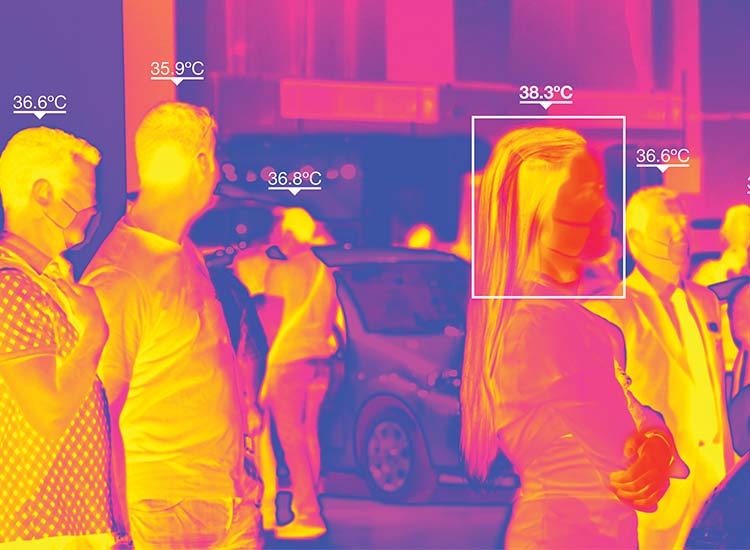Thermal camera systems taking the temperature of COVID-19
Organisations need to consider investing now in technology tools that create a more COVID-19-resistant and responsive workplace for the longer term.
An elevated temperature is one of the key symptoms of COVID-19, yet small body temperature changes are often unnoticed or dismissed by people in the early stages or mild forms of the virus. Despite being contagious, people may continue their daily interactions instead of self-isolating or seeking medical help.
Thermal camera systems are a quick and accurate way of identifying people with elevated body temperatures. The first systems were deployed in China in early January and then thousands were deployed across Asia and proved an essential part of their battle with COVID-19. Since early April systems have been installed around the UK, by the NHS, Sky, and in sectors such as education, food manufacturing and call centres.
How do they work?
Face detection algorithms target the skin temperature reading on the inner part of your eyeball near the tear ducts, which is the closest to your core temperature. AI algorithms reduce false temperature alarms caused by environmental influences.
How effective are they?
As a temporary solution, many companies are using hand-held scanners – but this increases the risk of cross-infection and puts operators at risk as well as taking 5-10 seconds to measure an individual’s temperature. To process 1,000 people would take 1½ to 3 hours.
In contrast, camera systems can be up to 800% faster, taking just 6 to 10 minutes to check the same number of people. That can be critical in high footfall areas such as airports and stadia where excessive queuing limits people flow and makes social distancing difficult.
What else needs to be considered?
To be effective you need more than just an off-the-shelf camera. It needs a blackbody device which emits a constant temperature within the field of view of the camera. This reference allows the system to calibrate other heat sources within the field of view to within +0.3C. Some systems only calibrate to +0.5c which is only suitable for animals and machinery.
You should also look for accuracy, and consider throughput and ease of daily use – and if your organisation shares a building, you will need to negotiate with the landlord and other tenants if the system is to be deployed in a reception area.
Thermal camera systems need a settled environment to work best, and a technical site survey is recommended to ensure the optimum effectiveness of the equipment.
As with any new technology, clear communications to both workforce and visitors about how it works will help ease its successful adoption. They need to understand that it is not a diagnostic tool, but a system that measures external and not internal temperatures. If it identifies an elevated body temperature, it may be a sign of fever, which may be a symptom of COVID-19 – but not necessarily so.
It is therefore essential to establish protocols for how to deal with anyone triggering the alarm indicating an elevated temperature. This, as a minimum, must involve HR, Health & Safety and Security.
Organisations must consider GDPR compliance and remember that health data is classed as “special category data”. You must be open about why you are collecting and using any data and how long you plan to keep any recordings from the system. I would suggest no more than a day if no alarms have been triggered.
There also needs to be understanding that the system only uses face detection algorithms to improve accuracy of readings as opposed to face recognition which needs a database. Where we have already deployed systems, the workforces have been very positive and welcoming.
Will we need thermal camera systems in the future?
As virus lockdown restrictions are lifted, it is becoming clear that “normal” will not return for millions of businesses and organisations. They will need to invest now in technology tools that create a more COVID-19-resistant and responsive workplace or venue for the longer term.
Thermal systems are not a solution in themselves, but one of a range of integrated infrastructure tools and improvements that businesses such as restaurants, event venues, places of worship, schools and office blocks can deploy as part of what will become a normal contactless entry journey to help minimise the risk of COVID-19.
This will require clear strategy and policy guidelines so that staff and visitors will accept that this is a way for organisations to protect them and help them psychologically to feel safer.
Mike O’Neill
MD of risk and resilience specialists, Optimal Risk


